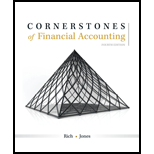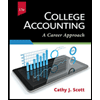
Cornerstones of Financial Accounting - With CengageNow
4th Edition
ISBN: 9781337760959
Author: Rich
Publisher: CENGAGE L
expand_more
expand_more
format_list_bulleted
Question
Chapter 2, Problem 65.1C
To determine
Introduction:
The moral principle which determines the action of a person or organization as right or wrong is called ethics. In this situation, the ethical dilemma is that whether Kathryn’s action of hiring her son, Ben who is not qualified for the job is correct or wrong.
Ethical issues involved.
Expert Solution & Answer
Want to see the full answer?
Check out a sample textbook solution
Students have asked these similar questions
Accounting
Please provide the correct answer to this financial accounting problem using valid calculations.
Please provide the correct answer to this general accounting problem using accurate calculations.
Chapter 2 Solutions
Cornerstones of Financial Accounting - With CengageNow
Ch. 2 - What is the conceptual framework of accounting?Ch. 2 - Prob. 2DQCh. 2 - Prob. 3DQCh. 2 - Prob. 4DQCh. 2 - Describe the constraint on providing useful...Ch. 2 - Prob. 6DQCh. 2 - Prob. 7DQCh. 2 - Prob. 8DQCh. 2 - Of all the events that occur each day, how would...Ch. 2 - Prob. 10DQ
Ch. 2 - Prob. 11DQCh. 2 - In analyzing a transaction, can a transaction only...Ch. 2 - How do revenues and expenses affect the accounting...Ch. 2 - Prob. 14DQCh. 2 - Prob. 15DQCh. 2 - The words debit and credit are used in two ways in...Ch. 2 - Prob. 17DQCh. 2 - Prob. 18DQCh. 2 - Prob. 19DQCh. 2 - Prob. 20DQCh. 2 - Prob. 21DQCh. 2 - Prob. 22DQCh. 2 - Prob. 1MCQCh. 2 - Prob. 2MCQCh. 2 - Prob. 3MCQCh. 2 - Prob. 4MCQCh. 2 - Prob. 5MCQCh. 2 - Which principle requires that expenses be recorded...Ch. 2 - Taylor Company recently purchased a piece of...Ch. 2 - Prob. 8MCQCh. 2 - The effects of paying salaries for the current...Ch. 2 - Which of the following statements is false? The...Ch. 2 - Which of the following statements are true? Debits...Ch. 2 - Debits will: increase assets. expenses, and...Ch. 2 - Which of the following statements are true? A...Ch. 2 - Posting: involves transferring the information in...Ch. 2 - A trial balance: lists only revenue and expense...Ch. 2 - CORNERSTONE 2.1 Cornerstone Exercise 2-16...Ch. 2 - Prob. 17CECh. 2 - CORNERSTONE 2.1 Four statements are given below....Ch. 2 - Prob. 19CECh. 2 - Cornerstone Exercise 2-20 Transaction Analysis...Ch. 2 - Cornerstone Exercise 2-21 Transaction Analysis...Ch. 2 - Cornerstone Exercise 2-22 Transaction Analysis The...Ch. 2 - Cornerstone Exercise 2-23 Debit and Credit...Ch. 2 - Cornerstone Exercise 2-24 Journalize Transactions...Ch. 2 - Cornerstone Exercise 2-25 Journalize Transactions...Ch. 2 - Cornerstone Exercise 2-26 Preparing a Trial...Ch. 2 - Prob. 27BECh. 2 - Brief Exercise 2-28 Assumptions and Principles...Ch. 2 - Brief Exercise 2-2? Events and Transactions...Ch. 2 - Brief Exercise 2-30 Transaction Analysis Galle...Ch. 2 - Brief Exercise 2-31 Debit and Credit Procedures...Ch. 2 - Brief Exercise 2-32 Journalize Transactions Galle...Ch. 2 - Brief Exercise 2-33 Posting Journal Entries Listed...Ch. 2 - Brief Exercise 2-34 Preparing a Trial Balance The...Ch. 2 - Prob. 35ECh. 2 - Prob. 36ECh. 2 - Exercise 2-37 Events and Transactions Several...Ch. 2 - Exercise 2-38 Events and Transactions The...Ch. 2 - Exercise 2-39 Transaction Analysis OBJECTIVE e The...Ch. 2 - Exercise 2-40 Transaction Analysis Amanda Webb...Ch. 2 - Exercise 2-41 Transaction Analysis and Business...Ch. 2 - Exercise 2-42 Inferring Transactions from Balance...Ch. 2 - Exercise 2-43 Transaction Analysis Goal Systems, a...Ch. 2 - Exercise 2-44 Transaction Analysis OBJECTIVE 9...Ch. 2 - Prob. 45ECh. 2 - Exercise 2-46 Normal Balances and Financial...Ch. 2 - OBJECTIVE 9 Exercise 2-47 Debit and Credit Effects...Ch. 2 - Prob. 48ECh. 2 - Exercise 2-49 Journalizing Transactions Kauai...Ch. 2 - Exercise 2-50 Journalizing Transactions Remington...Ch. 2 - Exercise 2-51 Transaction Analysis and Journal...Ch. 2 - Exercise 2-52 Accounting Cycle Rosenthal...Ch. 2 - Exercise 2-53 Preparing a Trial Balance...Ch. 2 - Exercise 2-54 Effect of Errors on a Trial Balance...Ch. 2 - Problem 2-55A Events and Transactions The...Ch. 2 - Problem 2-56A Analyzing Transactions Luis Madero,...Ch. 2 - Problem 2-57A Inferring Transactions from...Ch. 2 - Prob. 58APSACh. 2 - Problem 2-59A Journalizing Transactions Monroe...Ch. 2 - Problem 2-60A Journalizing and Posting...Ch. 2 - Problem 2-61A The Accounting Cycle Karleens...Ch. 2 - Problem 2-62B Comprehensive Problem Mulberry...Ch. 2 - Prob. 55BPSBCh. 2 - Prob. 56BPSBCh. 2 - Prob. 57BPSBCh. 2 - Problem 2-58B Debit and Credit Procedures A list...Ch. 2 - Problem 2-593 Journalizing Transactions Monilast...Ch. 2 - Problem 2-603 Journalizing and Posting...Ch. 2 - Problem 2-6B The Accounting Cycle Sweetwater...Ch. 2 - Problem 2-62B Comprehensive Problem Mulberry...Ch. 2 - Prob. 63.1CCh. 2 - Prob. 63.2CCh. 2 - Prob. 63.3CCh. 2 - Prob. 64.1CCh. 2 - Prob. 64.2CCh. 2 - Case 2-64 Analysis of the Effects of Current Asset...Ch. 2 - Prob. 64.4CCh. 2 - Prob. 65.1CCh. 2 - Prob. 65.2CCh. 2 - Prob. 66.1CCh. 2 - Prob. 66.2CCh. 2 - Prob. 66.3CCh. 2 - Case 2-67 Comparative Analysis: Under Armour,...Ch. 2 - Prob. 67.2CCh. 2 - Case 2-67 Comparative Analysis: Under Armour,...Ch. 2 - Case 2-68 Accounting for Partially Completed...Ch. 2 - Prob. 68.2CCh. 2 - Prob. 69.1CCh. 2 - Case 2-69 CONTINUING PROBLEM: FRONT ROW...Ch. 2 - Case 2-69 CONTINUING PROBLEM: FRONT ROW...
Knowledge Booster
Similar questions
- I need help with this general accounting problem using proper accounting guidelines.arrow_forwardPlease explain the solution to this general accounting problem with accurate explanations.arrow_forwardPlease provide the accurate answer to this general accounting problem using valid techniques.arrow_forward
- Can you solve this general accounting problem with appropriate steps and explanations?arrow_forwardPlease explain the solution to this general accounting problem using the correct accounting principles.arrow_forwardI need guidance with this general accounting problem using the right accounting principles.arrow_forward
arrow_back_ios
SEE MORE QUESTIONS
arrow_forward_ios
Recommended textbooks for you
- Principles of Accounting Volume 1AccountingISBN:9781947172685Author:OpenStaxPublisher:OpenStax College
 College Accounting (Book Only): A Career ApproachAccountingISBN:9781337280570Author:Scott, Cathy J.Publisher:South-Western College Pub
College Accounting (Book Only): A Career ApproachAccountingISBN:9781337280570Author:Scott, Cathy J.Publisher:South-Western College Pub

Principles of Accounting Volume 1
Accounting
ISBN:9781947172685
Author:OpenStax
Publisher:OpenStax College

College Accounting (Book Only): A Career Approach
Accounting
ISBN:9781337280570
Author:Scott, Cathy J.
Publisher:South-Western College Pub